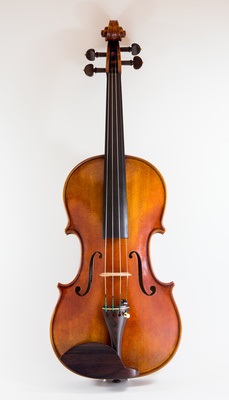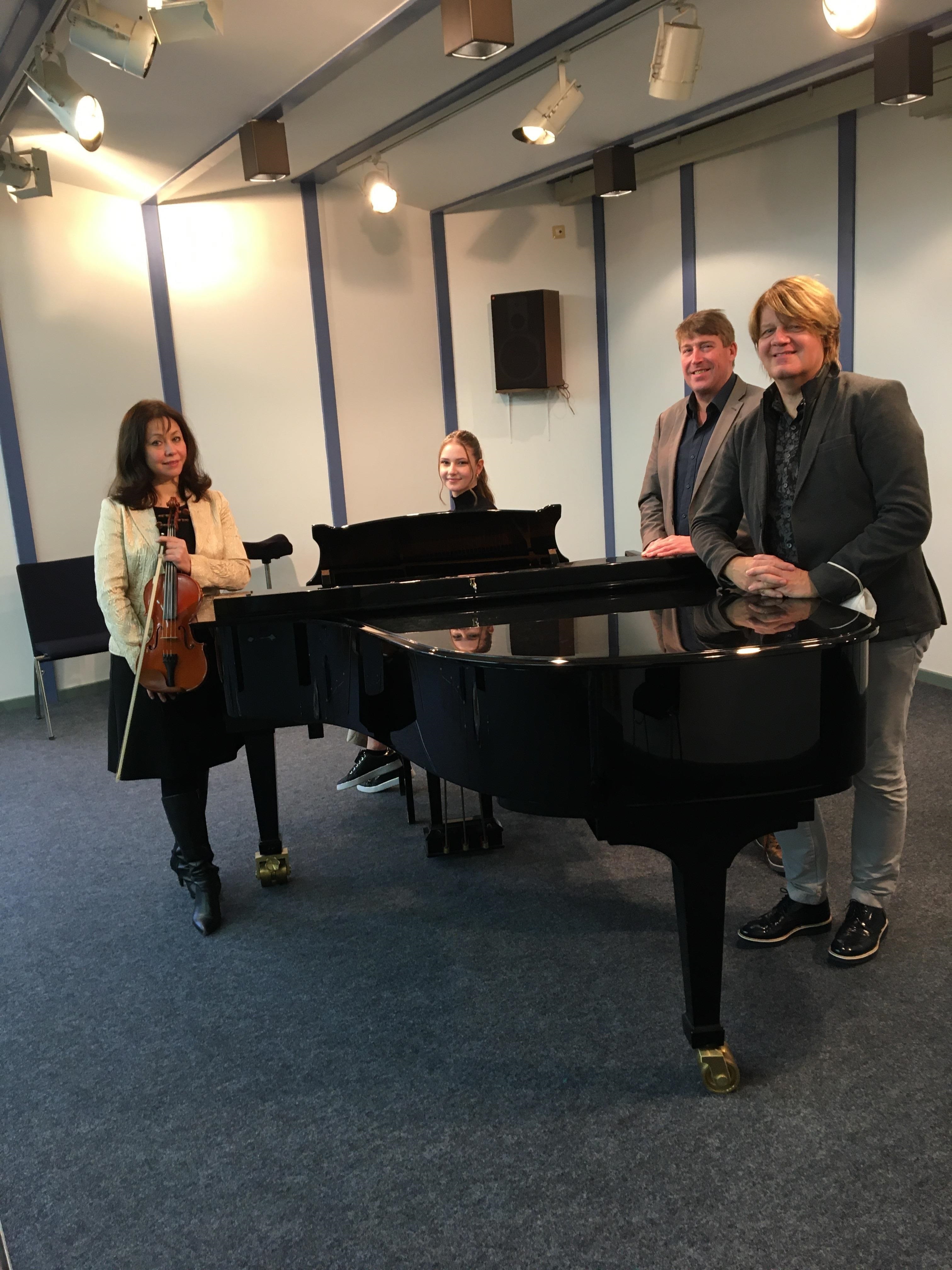String instruments
In stringed instruments, the sound is produced by the vibrations of a string. In most cases, the vibrations are produced with a bow. The sound is amplified by a soundboard.
The music school offers lessons on the four most common string instruments: violin, viola, violoncello and double bass.
-
Violin and viola
 Rainer Sturm / pixelio.de
Rainer Sturm / pixelio.deThe violin and viola belong to the family of string instruments. The notes are produced by striking the strings with a bow. The violin, also known as the violin, is the smallest classical string instrument. The viola, also known as the "viola", has a somewhat deeper and fuller sound. Both instruments are used both as soloists and in chamber music (for example as a duo with piano or with other string instruments) and of course in the orchestra. The repertoire primarily covers "classical music" from early baroque to classical and romantic to contemporary music. However, there are also opportunities to participate in folk music and, less frequently, in rock/pop bands.
From what age can you learn the violin and viola?Ideally, you can take your first lessons on small children's instruments when you start school, but a later start is certainly possible. In addition to individual lessons, the music school also offers group lessons (2-3 pupils are recommended). It is also possible to switch from violin to viola at any time. A good ear, fine motor skills and a good dose of patience and discipline are good prerequisites for successfully learning the violin or viola.
Where can I get a suitable instrument?To begin with, an instrument can be borrowed from the music school. If you want to buy your own instrument later, the teacher will be happy to advise you.
What opportunities are there to play along?If you play the violin or viola, you have the opportunity to take part in various ensembles: (Sinfonietta string ensemble, music school orchestra). The folk ensemble "Clover" is also looking forward to new members.
Lecturers:
- Kristina Klaus
- Jooeun Kong
- Hans Ulrich Kolf
- Lucia-Mariana Matei
- Olga Bereznitskaya
- Antje Parchmann
- City center, Goetheschule
- Fallersleben branch, Glockenberg School
- Detmerode branch, Waldorf School
- Vorsfelde branch, Ludwig-Klingemann-Haus
- Information on registration/fee schedule
Foundation of a violin class according to the Suzuzki method

In a 1-year trial phase, the music school of the city of Wolfsburg will set up a violin class based on the Suzuki method from 01.01.2022. This will be led by the director of the North German Suzuki Institute, Olga Bereznitskaya.
The Suzuki method is a special form of violin instrumental teaching named after its founder, the Japanese music teacher Shinichi Suzuki. This teaching concept is an alternative to regular violin lessons and is based on a significantly earlier start to lessons and an increased willingness to perform on the part of the pupils and their parents.
Kai-Uwe Hirschheide, City Councillor and Head of Cultural Affairs, welcomes the initiative: "The Suzuki method has become increasingly established in music schools in Germany in recent years. I am therefore delighted for our music school that we have been able to recruit Ms. Bereznitskaya, an outstanding violinist and teacher, as a Suzuki lecturer and thus enrich the range of lessons with a new facet."
The students will receive a combination of individual and group lessons of 65 minutes per week. The music school is providing Melanie Becher, a very talented active student of the music school, as piano accompanist for the new program. The fee for the pupils is 100.00 euros per pupil per month.
Characteristic features of the Suzuki method include
Early instrumental lessons
- Children are taught to play an instrument from pre-school age.
Learning by imitation
- As with the mother tongue, there is no reading of notes in the initial phase (first speaking, then reading and writing). The children learn their instrument by listening, imitating and improving.
Individual learning pace
- Each child determines their own learning pace through their ability to concentrate and their willingness to perform.
Active parental involvement
- One parent should be present in person during the first few years of lessons to support the child when practicing at home.
Combination of group and individual lessons
- The weekly individual lessons are supplemented by group lessons with piano accompaniment.
-
Violoncello

The cello is the third largest instrument in the string instrument family. It is larger than the violin and viola, but smaller than a double bass.
Unlike the violin and viola, the instrument is held upright between the legs and stands on the floor with an extendable metal spike. Due to its wide range, the cello is a very versatile instrument. With its low, sonorous register, it is often used as an accompanying instrument, but it can also be used to play very virtuoso solo pieces that almost reach the range of a viola or violin. The first pieces for cello were composed as early as the 17th century, and the repertoire extends to contemporary compositions. Even though the cello is mainly known to many as a classical instrument, it can also be used to play other styles such as jazz, rock or pop.
This is what the cello sounds like:
A good age to start lessons is between 6 and 8 years old, but in principle it is possible to start at any age. No previous musical knowledge is required.
Lessons are usually given on a one-to-one basis, but small group lessons are also possible.
Where can I get a suitable instrument?
The music school has violoncellos in all sizes that can be borrowed.Where can I play the cello?
With the cello you can quickly make music with others in ensembles, for example in one of the string groups or in individually arranged chamber music groups. Advanced students can play in the music school's orchestra, but also in bands such as the folk band "Clover".Lecturers:
- Charlotte Kiefer
- Luisa Schröder
Teaching locations:
- City center, Goetheschule
- Detmerode branch, Waldorf School
- Vorsfelde branch, Ludwig-Klingemann-Haus
- Information on registration/fee schedule
-
Double bass

The double bass is a very versatile string instrument. In classical music, it is of course present in the symphony orchestra, but also in chamber music ensembles and even as a solo instrument. But it can do so much more!
It is an integral part of jazz and has also established itself in blues, folk, bluegrass, country, rockabilly and even most varieties of pop.
At the music school, both beginners and advanced players will find optimal support in a wide variety of styles.
By including the bass ukulele as a teaching instrument, lessons can begin from the age of 6. At the age of 8, you can then switch to the double bass. Previous knowledge is not necessary. With a few exceptions, lessons take place on a one-to-one basis.Where can I get a suitable instrument?
The music school provides rental instruments to start with. Your teacher will be happy to advise you on buying your own instrument.
Lecturers:
- André Neygenfind
Teaching locations:
- City center, Goetheschule
How much do the lessons cost?
- Note on registration/fee schedule
